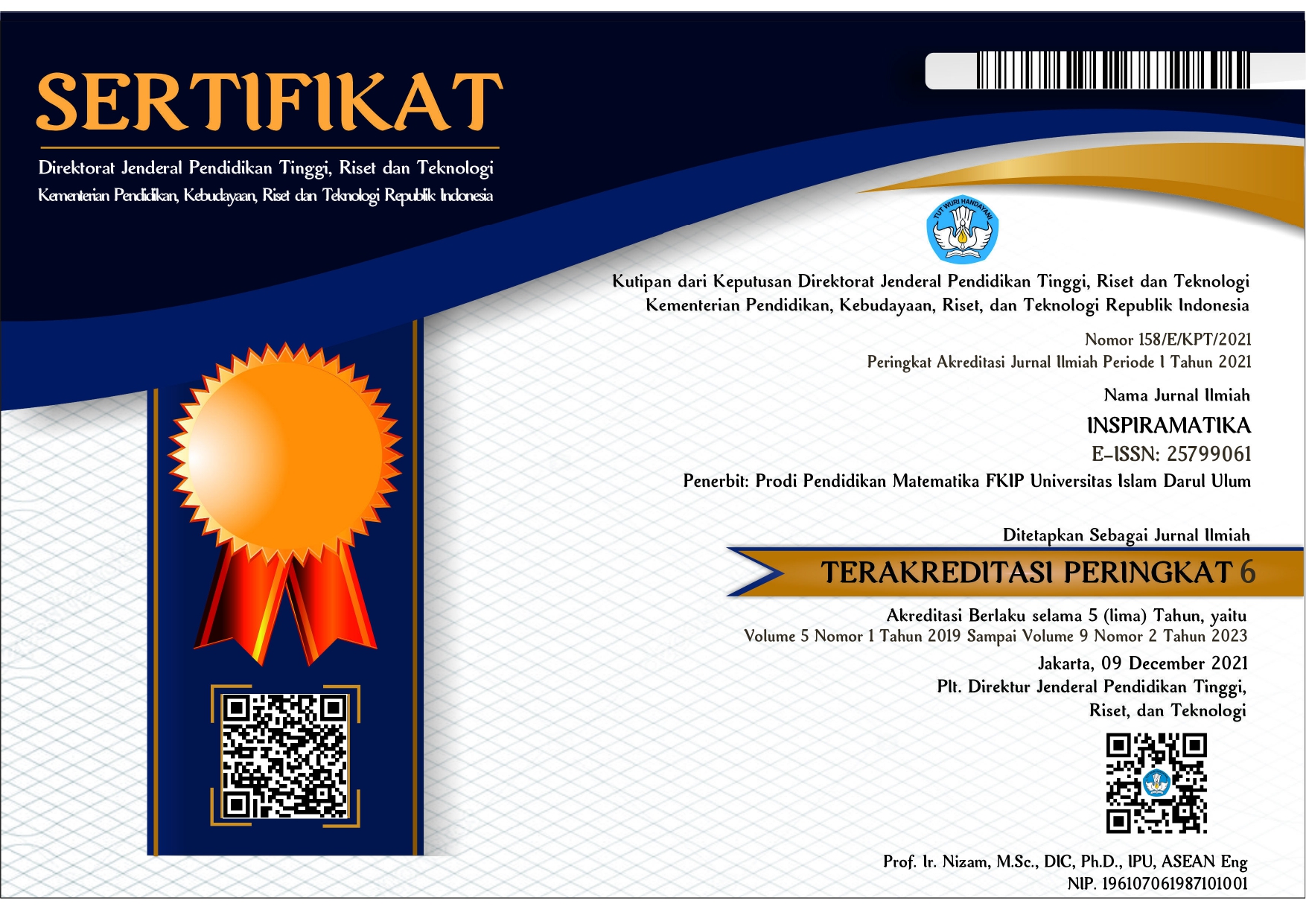PROFIL KOMUNIKASI MATEMATIKA TERTULIS DALAM PEMECAHAN MASALAH MATEMATIKA DI SMP DITINJAU DARI KEMAMPUAN MATEMATIKA
Abstract
This research aims to describe the profile of written mathematics communication in the mathematics problems solving of SMP in terms of the mathematics ability. This research is a qualitative research because the main data about the accuracy, completeness, and fluency of written mathematics communication in the form of written words. Subjects consisted of one student with high, medium, and low mathematics ability. The results of research indicate that the accuracy of written mathematics communication of students with high and medium mathematics ability is equally accurate for any information submitted. The accuracy of written mathematics communication of students with low mathematics ability is accurate to write the things that are known and asked and use rule. The completeness of written mathematics communication of students with high mathematics ability is complete for any information submitted. The completeness of written mathematics communication of students with medium mathematics ability is complete for information submitted except calculation. The completeness of written mathematics communication of students with low mathematics ability is complete for information submitted except for drawing/sketching and performing calculations. The fluency of written mathematics communication students with high and medium mathematics ability is equally fluent. The fluency of written mathematics communication students with low mathematics ability is not fluent.
Downloads
References
Ansari, B. I. (2003). Menumbuhkembangkan Kemampuan Pemahaman dan Komunikasi Matematika Siswa SMU melalui Strategi Think-Talk-Write. Disertasi tidak diterbitkan. Bandung: Program Pascasarjana Pendidikan Indonesia.
Asmana, A. T. (2015). Pengembangan Rubrik Analitik Asesmen Komunikasi Matematika Tertulis dalam Pemecahan Masalah Open-Ended. Tesis tidak diterbitkan. Malang: Program Pascasarjana Universitas Negeri Malang.
Depdikbud. (2016). Permendikbud Nomor 21 Tahun 2016 tentang Standar Isi Pendidikan Dasar dan Menengah. Jakarta: Depdikbud.
Dewi, I. (2009). Profil Komunikasi Matematika Mahasiswa Calon Guru Ditinjau dari Perbedaan Jenis Kelamin. Disertasi tidak diterbitkan. Surabaya: Program Pascasarjana Universitas Negeri Surabaya.
Ginsburg, H. P. (1982). Children’s arithmetic: The learning process. Austin, TX: Pro-Ed.
Hirschfeld-Cotton, K. (2008). Mathematical Communication, Conceptual Understanding, and Students' Attitudes Toward Mathematics. Action Research Projects (Paper 4). http://digitalcommons.unl.edu/cgi/vieviewcont.cgi?article=1011&context=mathmidactionresearch.
Isroil, A., Budayasa, I. K., & Masriyah. (2017). Profil Berpikir Siswa SMP dalam Menyelesaikan Masalah Matematika Ditinjau dari Kemampuan Matematika. Jurnal Review Pembelajaran Matematika, Vol.2(2), pp. 93–105. http://jrpm.uinsby.ac.id/index.php/jrpm/article/download/34/31
Kim, M. K. & Noh, S. (2010). Alternative Mathematics Assessment: A Case study of the Development of Descriptive Problems for Elementary School in Korea. Eurasia Journal of Mathematics, Science & Technology Education, Vol. 6(3), pp. 173-186.
Moleong, L. J. (2009). Metode Penelitian Kualitatif. Bandung: PT. Remaja Rosdakarya.
NCTM. (2000). Principles and Standards for School Mathematics. Reston, Va.: NCTM, Inc.
Ozdemir, S. & Reis, Z. A. (2013). The Effect of Dynamic and Interactive Mathematics Learning Environments (DIMLE), Supporting Multiple Representations, on Perceptions of Elementary Mathematics Pre-Service Teachers in Problem Solving Process. Mevlana International Journal of Education (MIJE), Vol. 3(3), pp. 85-94.
Polya, G. (1973). How to Solve It: A New Aspect of Mathematical Method (Second Edition). New Jersey: Princeton University Press.
Pusat Bahasa Depdiknas. (2008). Kamus Besar Bahasa Indonesia. Jakarta: Pusat Bahasa.
Shodikin, A. (2015). Interaksi Kemampuan Awal Matematis Siswa dan Pembelajaran Dengan Strategi Abduktif-Deduktif Terhadap Peningkatan Kemampuan Penalaran dan Disposisi Matematis Siswa. Inspiramatika, Vol. 1(1), pp. 61-72.
Soedjadi, R. (2000). Kiat Pendidikan Matematika di Indonesia. Konstatasi Keadaan Masa Kini Menuju Harapan Masa Depan. Jakarta: Direktorat Jenderal Pendidikan Tinggi, Departemen Pendidikan Nasional.
Sugiarto, H. & Budiarto, M. T. (2014). Kemampuan Komunikasi Matematika Siswa SMP dalam Pemecahan Masalah Ditinjau dari Kemampuan Matematika. Mathedunesa: Jurnal Ilmiah Pendidikan Matematika, Vol. 3(3), pp. 208–214.

This work is licensed under a Creative Commons Attribution-ShareAlike 4.0 International License.






.png)




